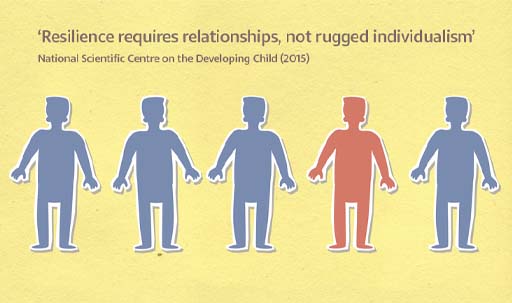1.1 Defining resilience
As you saw in the introductory video each of the young people described resilience in a different way. This reflects the academic perspective of this concept in that there are no standard definitions of resilience. While there have been attempts to quantify and measure it, most studies look at the concept qualitatively – as one group of researchers argued, ‘Rather like beauty, resilience may be said to lie in the eye of the beholder.’(Gilligan et al.,2014, p.1.).
Existing definitions of resilience have similar components, which involve doing well ‘against the odds’, coping, and recovering (Rutter, 1985; Stein, 2005).
- Psychologist Ann Masten and colleagues (1990) define resilience as the process of, capacity for, or outcome of successful adaptation despite challenging or threatening circumstances.
- Social researcher Robbie Gilligan (2000) defines it as a set of personal qualities that helps a person to withstand many of the negative effects of adversity.
- The British Psychological Society (2019, p. 2) defines resilience as ‘reduced vulnerability to environmental risk, the overcoming of stress or adversity, or a relatively good outcome despite risk experiences.’
The next activity will help you to untangle some of the technical language in these definitions.
Activity 2: Highlighting key terms
Re-read the three definitions given above and then have a go at highlighting some terms below.
Discussion
Definition statements are usually focused and condensed pieces of text. You may have wanted to highlight a large number of the terms.
This activity is designed to help you notice some of the variations between the definitions. Is resilience ‘successful adaptation’ as stated in statement 1 or is it ‘withstanding the negative effects of adversity’ as suggested by statement 2? (You’ll explore meanings of adversity in the next section).
In the first statement the word ‘adaptation’ gives a sense of learning and changing in response to experiences. While in the second statement the word ‘withstand’ portrays more of a focus on survival. In the third statement ‘reduced vulnerability’ appears to recognise resilience as a protective factor, and the word ‘overcoming’ draws our attention to the challenges and having a good outcome.
You can also discern a contrast between the idea of resilience being a process (statement 1) as well as being a quality in a person.
When deciding if a young person is showing resilience, be aware that what might appear to be coping or resilient behaviour may be nothing of the sort. A young person developing anorexia might appear to be coping well if they are handing in their homework on time at school and seemingly getting on well with friends. As social workers Brigid Daniel and her colleagues note, ‘some young people who appear to be resilient may in fact be internalising their symptoms’ and while they may appear to cope in the short term are actually suffering greatly (Daniel, Wassell and Gilligan, 2010, p 70). When practitioners refer to ‘internalising symptoms’, they mean that a person may be developing anxiety or depression and becoming withdrawn, rather than giving out more open signs of distress such as aggression or impulsiveness, or dramatically falling behind at school. It is therefore important to consider all aspects of a young person’s behaviour when reflecting upon whether they might be struggling with something.
By now, you have probably realised that the concept of resilience is far from clear cut. But how far would you consider that resilience is embedded in an individual? The next activity asks you to decide.
Activity 3: Your views on resilience
Study the quote in Figure 3 from the National Scientific Centre on the Developing Child and consider what you think it means. Do you agree with it? Vote whether you agree or disagree, using the poll below.
The National Scientific Centre declaration drew upon academic research showing that one important reason why young people can overcome adversity is having one stable and committed caregiver or adult. It is suggested these relationships provide scaffolding that helps to buffer the effects of the adversity and help young people to adapt to changing circumstances.
Before looking further at resilience, it will help to consider next what people understand by the term ‘adversity’.

